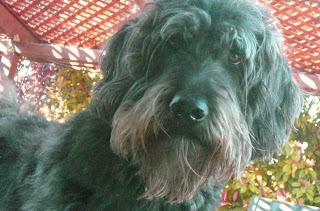
We picked her up on Saturday, April 30th, driving 5 hours north to Sacramento. There we met with the breeder and chatted for about 45 minutes. Then we turned right around and drove 5 hours home. We had purchased a puppy crate, but Lakota was not familiar with confinement. She went into howling fits as soon as she was crated. Impossible to drive home with that racket and bad for her as well, so I climbed into the back seat with her and with Yanqui, our 4 year old Labradoodle.
At first, the puppy whimpered - confused and separated from all she had previously known. I don't soothe with words or cuddles, but held her in a comfortable position, allowing her wiggle room. In about 20 minutes, her body found Yanqui's body and she dropped on the seat between us: he on one side; I on the other. There she found peace. Yanqui was very patient with her all the way home. Eventually, the pup moved between sitting on my lap and lying next to Yanqui. She was no longer in distress. She did not suffer from car sickness.
Today, Wednesday, is our 5th day together - fourth day at home.
At 7 weeks, 6 days, Lakota is an infant with an imperial schedule: eat, potty, rest, play. Repeat. Quite an adjustment for dogs and humans. My beautiful house looks terrible as I don't have time for anything but puppy right now.
Tomorrow she will be 8 weeks old. Today, she ate half her food allotment for breakfast (2 cups previously held her all day--3 feedings). I hand fed her, using clicker for eye contact. Right now I still wear a thin leather glove on the feeding hand because she has no idea where her baby teeth are nor how much they can hurt. If she senses "hand," she is gentle. When she is excited, she is not gentle. Ouch.
Being a GSD, Lakota has great natural eye contact. While we develop long and soft eye contact over time, using games, clicker, etc., I found that Lakota also responds to the "stink eye" and will stop whatever naughtiness she is up to. For example, if she has grabbed hold of my shirt and tries to shake it out, while I could pull the shirt out of her mouth or offer a toy, a strong stare will also break her concentration.
Last night, Yanqui began really playing with her. First day, he wanted to mount her and of course we could not allow that. Next couple of days, he wanted to pretend she wasn't here. Last night, they actually played a bit, and he was gentle. Appropriate. We were throwing a ball. He would chase it. As he tried to bring it in, she began herding him. It was wonderful to see her breed instincts come into play. She knew how to front him, how to circle him. At times, she lay flat, watching him like a Border Collie, to see which way he would try to run.
The biggest issue we have with her at this moment is that everything she sees must go immediately into her mouth. Although our yard seemed safe, I had not thought of "edibles" like a stray pebble or a hard lump of dirt. So we will keep her on the grass until she can handle other surfaces without eating them. An X-pen would be so useful here.
Lakota is handling the leash extremely well. Leash work (on the human end) reminds me of the fine hand an excellent rider develops in reining horses. A dog can feel even the faintest touch on a leash. If the dog puts neck pressure forward, we stand still and "pinch" the leash with our fingers. As soon as the dog relieves the pressure - whether by accident (his foot slips to the side) or design (he turns even slightly to see what you are doing) - we release the pinch and go immediately to loose leash. "Loose leash" is the reward and dogs respond beautifully to it.
Results on this are amazing. Lakota struggles occasionally, for a few seconds, but by patiently waiting for her tiny tantrum to cease and giving her the reward of a loose leash, a few kind words and a smile, she is learning quickly to enjoy walking with us.
We also utilize Yanqui because she will follow him. If all else fails, which can happen when she poops out and flops, we pick up her back end and put her back on her feet, then run away from her and she follows. She has a powerful follow instinct.
All in all, we are very pleased with Lakota. She is very pretty. Her coat is fantastic. Her eye contact is very strong, yet kind. She has some guts, which she has shown at the fence and with the outdoor cats. Of course, she is redirected when inappropriate with the cats, but the fact that she throws her tail over her back and responds to her interior belief that she is on home territory and these outdoor cats may not belong there, shows her character.
When something startles her, she handles it well, recovering very quickly. When she runs to me for shelter, I don't get involved and she readjusts and moves forward.
She is climbing into the crate on her own now and crated-puppy squalls have diminished by 75%. However, she is squalling right now, so it is potty time.
More on Lakota as she develops.








